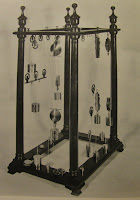Tschumi's response to the ambivalence of the idea-object is formulated in his conception of an 'event.' Considerations of program are generative of his projects. His architecture is a collage of uses - creating new possibilities of being in an urban space, that is, new 'events.'
Form and composition are denied - for Tshumi it is clear that on that level form can claim no coherence with ideas or uses. He chooses to emphasize a disjunction. Architecture becomes then an exercise in finding abstract intermediaries between the site and the programmatic demands.
 'crossprogramming: displacement and mutual contamination of terms'
'crossprogramming: displacement and mutual contamination of terms'In this sense he practices 'architecture as infrastructure,' that is, his buildings are
carriers of events. Consequently they are stripped to interlaced structural walkways and glass-bound volumes - applying the minimum necessary to join and complicate the web of city events, while providing a spectacle of the new juxtaposition (a pleasure particular to the city).

Fragmentation is favored over hierarchy. '
no design, no composition, but materialization of the construction concept'
'
programs fall into three categories: those that are indifferent to the spacial sequence; those that reinforce it; those that work against it'

The 'minimum,' however, sets structure off as an aesthetic pursuit. Now, Tschumi says, when
technology of construction is no longer a concern (with the technologies available that allow for more than is practically needed in building at this time) architects should focus on
construction of technology. - (which i take to mean:) devising of new urban systems, furthering new technologies of living. - an often element in his project is a multimedia screen. Allowing architecture to be constituted by transient images.


Notion of an image is recurring within his work: 1. in the form of projections on the aforementioned digital casings. 2. As public spectacle - flattened image seen through a glass screen.

'
removing the hierarchy between frame and image' - image getting loose in the linear core of The (proposed) Center for Art and Media in Karlsruhe '89.
F. Jameson describes how the image is 'of itself' an artifact in the postmodern. (so that it is rare to find images
of anything)
'the 'city,' a complex and interactive web of events'

Le Fresnoy '
there is no architecture without the city, no city without architecture'
Piranesi captured the experience...


 A chair and a 4-dimensional cube with point H in common.
A chair and a 4-dimensional cube with point H in common. even more fooling around. photoshop effects are so addictive. A triptych
even more fooling around. photoshop effects are so addictive. A triptych


 The 'minimum,' however, sets structure off as an aesthetic pursuit. Now, Tschumi says, when technology of construction is no longer a concern (with the technologies available that allow for more than is practically needed in building at this time) architects should focus on construction of technology. - (which i take to mean:) devising of new urban systems, furthering new technologies of living. - an often element in his project is a multimedia screen. Allowing architecture to be constituted by transient images.
The 'minimum,' however, sets structure off as an aesthetic pursuit. Now, Tschumi says, when technology of construction is no longer a concern (with the technologies available that allow for more than is practically needed in building at this time) architects should focus on construction of technology. - (which i take to mean:) devising of new urban systems, furthering new technologies of living. - an often element in his project is a multimedia screen. Allowing architecture to be constituted by transient images.
 'removing the hierarchy between frame and image' - image getting loose in the linear core of The (proposed) Center for Art and Media in Karlsruhe '89.
'removing the hierarchy between frame and image' - image getting loose in the linear core of The (proposed) Center for Art and Media in Karlsruhe '89.





 Finally, they are dynamic: obviously, as objects meant for movement, but even more so as fragments of some larger purpose-driven machinery they make potentially possible. In the latter sense they are very enigmatic (even though the principles of their operation are made visually apparent).
Finally, they are dynamic: obviously, as objects meant for movement, but even more so as fragments of some larger purpose-driven machinery they make potentially possible. In the latter sense they are very enigmatic (even though the principles of their operation are made visually apparent).